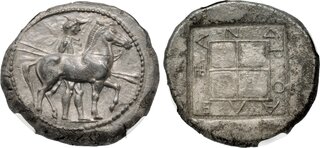| Classical Numismatic Group > Triton XXVII | Auction date: 9 January 2024 |
| Lot number: 142 Price realized: 9,250 USD (Approx. 8,472 EUR) Note: Prices do not include buyer's fees. | Show similar lots on CoinArchives Find similar lots in upcoming auctions on |
| Lot description: KINGS of MACEDON. Alexander I. 498-454 BC. AR Tristater – "Oktadrachm" (29.5mm, 28.30 g, 11h). Light Aeginetic standard. Aigai mint. Struck circa 476/5-460 BC. Horseman, petasos hanging from neck, holding two spears, standing right, behind horse standing right / AΛE-ΞA-NΔ-PO in shallow incuse square around quadripartite square in relief. Raymond Group II, 51 (A10/P13); AMNG III/2, 31 var. (no crescent); HGC 3, 755; BMC 1 (same obv. die); Dewing 1082 (same obv. die); Pozzi 815 (same dies). Toned. In NGC encapsulation 6709090-001, graded Ch AU, Strike: 5/5, Surface: 2/5. Ex Leu Numismatik AG 3 (27 October 2018), lot 42. By the end of the sixth century BC, the Kingdom of Macedon became an influential regional power, strategically located between the Persian Empire and the city-states of Greece. The wars with Persia further extended Macedon's importance, especially that of its young prince, Alexander I, son of Amyntas. An astute politician, Alexander succeeded to the throne in 498 BC and deftly maneuvered through this precarious situation as the Persians extended their power and influence into Greece proper. Alexander maintained an aloof but cordial relationship with the Persians as they moved through Thrace and Macedon, forcing other tribes to offer earth and water in tribute. At the same time, he worked towards a stronger association with the Greeks, who still regarded Macedon as semi-barbaric. Herodotos (9.44) says that on the eve of the battle at Plataia, Alexander entered the Athenian camp to report that a delay in engaging the Persians would help to further diminish their already low supplies. In return, he hoped the Greeks (in particular the Athenians) would assist him when the time came, thereby forging a relationship between the rising power in the north with the rising Greek city-states of Athens, Sparta and their allies. In 476 BC he was acknowledged as a full-blooded Greek himself and allowed to participate in the Olympic Games of that year. Alexander I was the first Macedonian king to strike coins in his own name and likely made use of the silver mines of Mount Dysoron, which he used his Persian connections to obtain early in his reign. His large silver pieces, such as this splendid example, are denominated as tristaters or oktadrachms on the "heavy Thraco-Macedonian standard," and were evidently intended for trade with the Persians and other Greek states. A lighter weight standard was employed for coins in local situation, a situation which continued down to the time when Macedon became the dominant power in Greece and Asia Minor. Estimate: 10000 USD |  |



